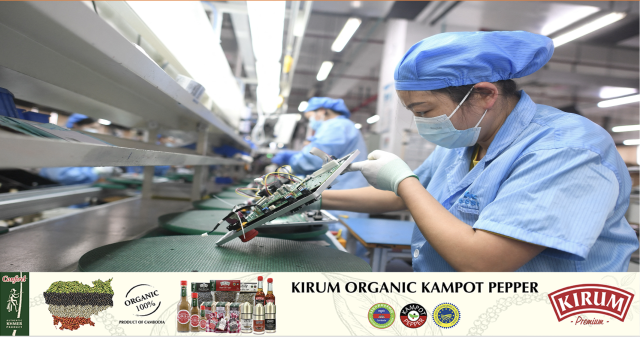What Can We Learn from China's Industrial Policy?

- By Chea Ty
- December 10, 2023 7:56 PM
A general practitioner from the US came to join Oktoberfest Munich and Marathon in Berlin and went to the pharmacy but could not find any medicine he used to prescribe for his patients in the US.
I told him the Belgian pharmacist once told me there is no aspirin in Belgium Pharmacy, only Paracetamol, which is almost the same but has a different generic licence.
The cost of capital input for research and development of intellectual property, such as medicine and technology, is usually higher than the cost of production. Many European countries would choose to buy licences and produce domestically, as it would reduce costs and create jobs.
Similarly, the Chinese economy during the post-Mao period depended on agriculture to feed labour forces, which enabled them to depreciate currency and attract exports. This strategy has been adopted by Asian tigers such as South Korea and Taiwan. However, China’s economy remained backward, and to catch up with developed countries, it needs capital, skills, and technology. To get this, it required the West. In the early 1990s, China began to open its economy to the world. China adopted an open-door policy and established a unique economic and technology zone. The Chinese policymaker was cautious about opening China to the world. The question is: How was China able to ensure that opening was in the best interest of China? How does this opening end up differently than it did during the late Qing dynasty and early Republic?
To ensure that this opening would benefit China, the Chinese government required that foreign companies establish joint ventures with Chinese companies should they want to select companies in China. This would help China in multiple ways.
First, as a joint venture company, a share of the profit would also stay in China. This, however, depends on the agreement between the two firms. Second, employees of Chinese firms would have the opportunity to acquire skills from foreign firms. Foreign companies would need to invest in training programmes to transfer skills and knowledge to the local workforce and build their manufacturing, engineering, and product development capacity.
The third most important is the transfer of technology. Some technology is quite expensive, and China might need more development time. This policy would guarantee the technology transfer to China because partnerships may involve sharing technology, localising production, and partnering in R&D efforts. In addition to the joint company policy, China also pushed for the production location. Massive tariffs will hit foreign companies that import components from broad and thus will be less competitive in domestic markets.
In addition to its abundant human labour, China's main bargaining strength lies in its market size. With a population of 1.12 billion, China was one of the largest single markets in the world and would likely become the largest single market. Though establishing joint companies with Chinese companies was a marriage of inconvenience for foreign companies, many companies decided to go to China, ranging from electronic and telecommunications companies like Motorola to heavy industries such as Caterpillar and Komatsu.
An example of this industrial policy can be seen in the construction industry in China. China's open-door policy led to the need for complex infrastructure to build such an extensive infrastructure. Some equipment, such as excavators, are high-end products that depend on high capital and technology input. It is expensive to import, making the building cost more expensive. A similar thing happened to South Korea's textile industry in the 1970s. For sectors, countries needed to import machinery as they could not produce their own. Therefore, it reduced the profit of textile products. The South Korean government banned the import of textile machinery and turned it into a metal workshop to produce its machinery, and the increasing cost was passed on to consumers. However, South Korea could later play competitive role in producing machinery in the world market.
China would also prefer to manufacture its equipment domestically to reduce costs. However, the Chinese firm needed more capacity to produce it due to the technology required for the product. To solve the problem, China forced foreign firms to form joint ventures to access the Chinese market to increase the flow of technology in China, which increased the capacity for Chinese firms to produce construction equipment. Giant heavy construction companies like Caterpillar and Komatsu went to China. For instance, Caterpillar Xuzhou Limited (CXL) was formed as a joint venture between Caterpillar and Xuzhou Construction Machinery Group Co., Ltd (XCMG) in 1994.
Brandt and Thun's study illustrates how the joint venture and localisation of production led to the increasing capacity of Chinese firms to produce their equipment. The foreign firm refused to localise its capital incentive component, fearing the Chinese firm would copy the technology. However, foreign firms must outsource production in China over time to remain competitive in the Chinese market.
Brandt and Thun also interviewed Chinese domestic firms, and they found that to maintain the competitiveness of products manufactured by their subsidy company, foreign companies provide technical assistance to identify the product problem and find domestic suppliers in China capable of delivering high-quality components. In cases where there are no qualified domestic suppliers, foreign companies invest resources to improve supplier capability. Over time, China will also be able to produce wheel loaders at competitive prices and make excavators independently.
Today, China can build massive infrastructure at a lower cost as the equipment and labour are primarily based in China. China can also send its SMEs to build infrastructure abroad.
Of course, Cambodia possesses a smaller market compared to that of China. Thus, it cannot follow the success story. However, one can learn the elements of success and failure from other countries that catch up with the West, from the Asian tigers to the failure to industrialise in Latin America. These countries share similar patterns and differences in their policy. Cambodia can tailor these lessons to fit its unique circumstances and strengths for long-term industrial growth.
Chea Ty holds a joint MA from Leipzig and Ghent University under the Erasmus Joint Master Scholarship programme. He is also a former exchange student at KU Leuven















